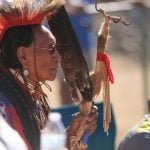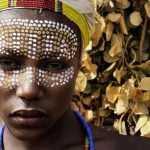Shellfish and The California Tribes
Long before the arrival of Europeans, the Pacific Ocean provided the Indian Nations of California with an abundance of shellfish: clam, abalone, mussel, olivella, and dentalium. These provided not only food, but the shells were the raw material for beads, jewelry, currency, and fishhooks.
Archaeology has found that clamshells – Saxidomus nuttalli and Tivela stultorum – have been used to make beads since about 1200 AD. Clamshell beads were traded inland into central California and Nevada. The clamshell beads, also called clam disc beads, are flat, white, and round. They are drilled in the center and can be up to one inch in diameter. Some of the clamshell beads made by the Coast Miwok were tiny and a great deal of work was required to grind them to a small size. Therefore, these small clamshell beads were not worn as casual or ornamental jewelry, but were considered to be a form of wealth which could be given to others or inherited.
The Coast Miwok traded clamshell beads and abalone shells to the Wappo and Pomo for obsidian. Clamshell beads were also used as a kind of money which could be used to pay for songs and prayers, dancers, doctors, and instruction in special skills. Among the Coast Miwok, men tended to be the beadmakers.
Olivella shells (Olivella biplacata) were either strung whole for jewelry or they were used for making small sequins for decorating ceremonial items. Unlike the clamshell beads, beads made from olivella were not used for money. Their use by the Hoopa, Yurok, Karuk, Wiyot, and Miwok was primarily ornamental.

Shown above is a photograph of a Hupa shaman by Edward Curtis. Notice the shell beads.
Olivella beads were also used on baskets. Some of the large coiled baskets displayed in some museums have designs in white sequin-sized beads. Each of the beads was stitched in place as the basket was woven.
Many different species of abalone are found in the Pacific waters. Abalone meat was considered a delicacy and the shells were made into large ornaments, fishhooks, and beads.

Shown above is a Wishram woman photographed by Edward Curtis who is wearing a dentalia bridal shell headdress and earrings.
Dentalium hexagonum is a shell which is shaped like a small tusk. While it is not native to the California area (it is found off Vancouver Island in British Columbia, Canada) it was widely used by the California Indians for money, ornaments, necklaces, pendants, and earrings.
In California there were two different types of shell beads. The first of these were the “money” beads which could be obtained by selling goods (both food and manufactured products such as baskets). “Money” beads could be used by anyone. Among the Yurok, Karuk, and Hupa, dentalium could be used as a kind of money for arranging marriages, settling debts, and in other situations. The shells were usually kept in long strings. There were some individuals who had lines tattooed on their arms for measuring the strings of beads.
The Chumash also manufactured the flat shell beads which were used as a form of currency throughout California.
The second type of shell beads were associated with social class or rank. In northern California, wealth permeated every aspect of the Native American cultures and great importance was placed on the accumulation and display of personal wealth.



